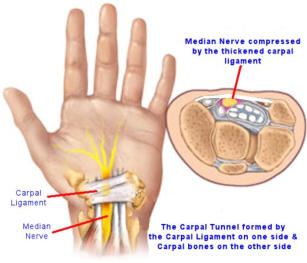

Information for the General Public
Carpal Tunnel Syndrome
If
you
suffer
from
pins
and
needles
or
numbness
affecting
the
thumb,
index
or
middle
fingers
you
are
probably
suffering
from
carpal
tunnel
syndrome.
It
affects
about
5%
of
the
population
and
women
are
affected
more
often
than
men.
The
first
time
it
happens is usually at night when you wake up with an uncomfortable tingly feeling in your fingers.
The
carpal
tunnel
is
a
narrow
passage
in
the
wrist
through
which
the
tendons
that
move
the
fingers
and
a
major
nerve
(median
nerve)
passes
through.
The
nerve
innervates
a
few
small
muscles
in
the
hand
and
is
also
responsible
for
sensation
of
the
thumb,
index,
middle
and
half
of
the
ring
finger.
The
tunnel
is
made
up
of
wrist
bones
on
one
side
bridged
by
a
tough
ligament
for
the
roof
on
the
other.
When
the
space
in
the
tunnel
occupied
by
the
tendons
and
nerve
is
reduced
from
any
cause,
the
nerve
gets
squeezed
and
carpal
tunnel
syndrome results.
Incidence:
It
often
affects
people
who
indulge
in
continuous
repetitive
work
involving
the
hands
and
wrist.
Among
people
involved
with
manual
labour,
it
affects
those
who
use
a
pneumatic
drill
or
a
jack
hammer
at
work.
Among
office
workers,
secretaries,
clerks
and
software
engineers,
it
may
affect
those
who
constantly
use
a
key
board.
It
can
also
occur
after
an
injury
to
the
wrist.
Symptoms
may
also
appear
when
excessive
fluid
collects in the body as during pregnancy or when you suffer from diabetes.
Symptoms:
When
mild,
symptoms
are
noticed
during
the
night.
People
usually
wake
up
with
numbness
and
a
feeling
of
pins
and
needles
in
the
fingers.
Symptoms
may
ease
when
you
shake
your
hand
vigorously
or
let
your
hand
hang
by
the
side
of
the
bed.
With
increased
pressure
on
the
nerve
symptoms
become
constant
and
often
noticed
during
the
daytime
while
at
work.
When
it
progresses
further
the
small
muscles
that
move
the
thumb
become
weak
and
appear
wasted.
Pain
may
sometimes
radiate in to the forearm.
Diagnosing
Carpal
Tunnel
Syndrome
:
It
is
usually
diagnosed
by
clinical
examination.
Tapping
the
nerve
at
the
wrist
may
produce
pins
and
needles
shooting
to
the
fingers.
Similarly
bending
the
wrist
to
its
extreme
position
can
cause
numbness
in
any of the fingers supplied by the nerve.
Electromyogram
and
nerve
conduction
study
are
tests
that
will
confirm
increased
pressure
on
the
nerve.
They
are
simple
tests done in the outpatient clinic.
Treatment:
Treatment
can
vary
from
simple
measures
when
symptoms
are
mild
to
surgery
when
they
are
severe
affecting
ones
daily
activities.
If
possible,
the
person
affected
must
be
advised
to
rest
the
hand
and
wrist
and
avoid
any
activity
causing
repetitive strain on the wrist.
If
symptoms
occur
during
pregnancy,
they
normally
settle
down
after
the
baby
is
born.
In
diabetics,
symptoms
improve
when
sugar
levels
are
well
controlled.
When
there
is
excessive
fluid
build-up,
the
cause
for
increased
fluid
in
the
body
must be found and treated.
Wrist
Splint:
The
splint
usually
worn
at
night,
will
support
the
wrist.
It
will
prevent
the
wrist
from
bending
that
normally
increases
the
pressure
on
the
nerve.
You
may
be
able
to
purchase
it
from
a
chemist
or
an
online
supplier.
The
splint is useful when symptoms are mild.
Steroid
Injection
:
Injecting
steroid
in
to
the
carpal
tunnel
may
reduce
the
inflammation
and
thereby
the
swelling
relieving
the
symptoms.
Care
must
be
taken not to inject the drug in to the nerve or the tendons.
Oral anti-inflammatory medication only rarely helps.


Wrist Splint